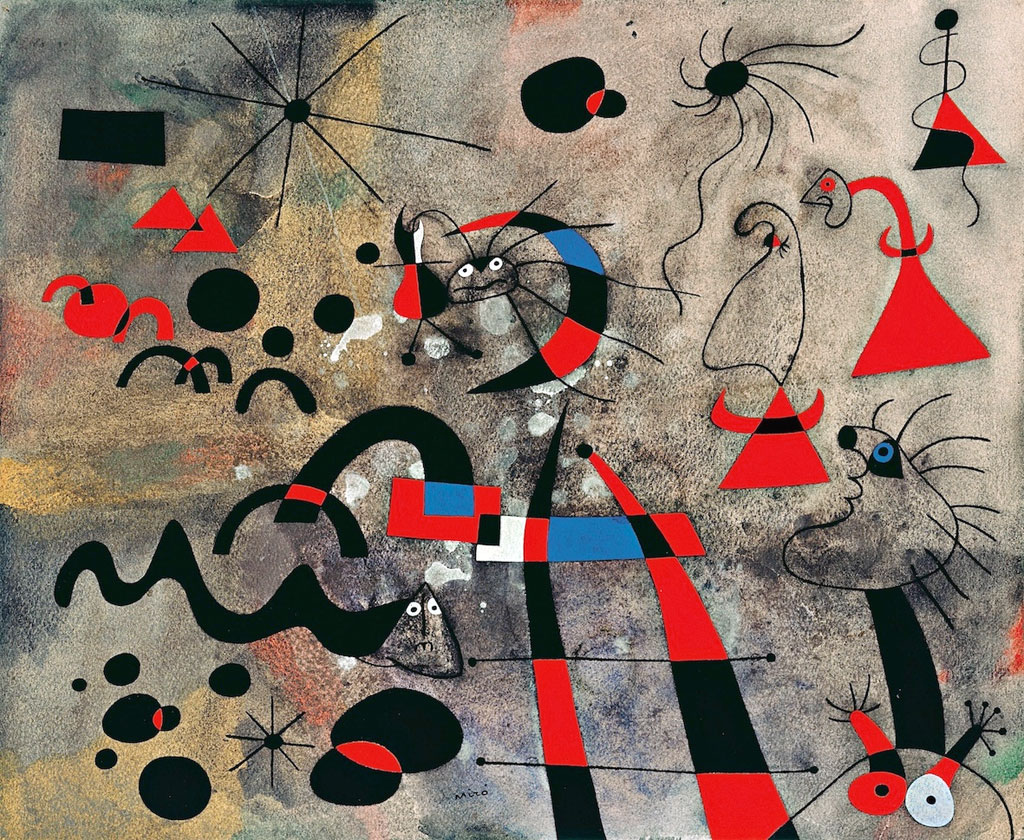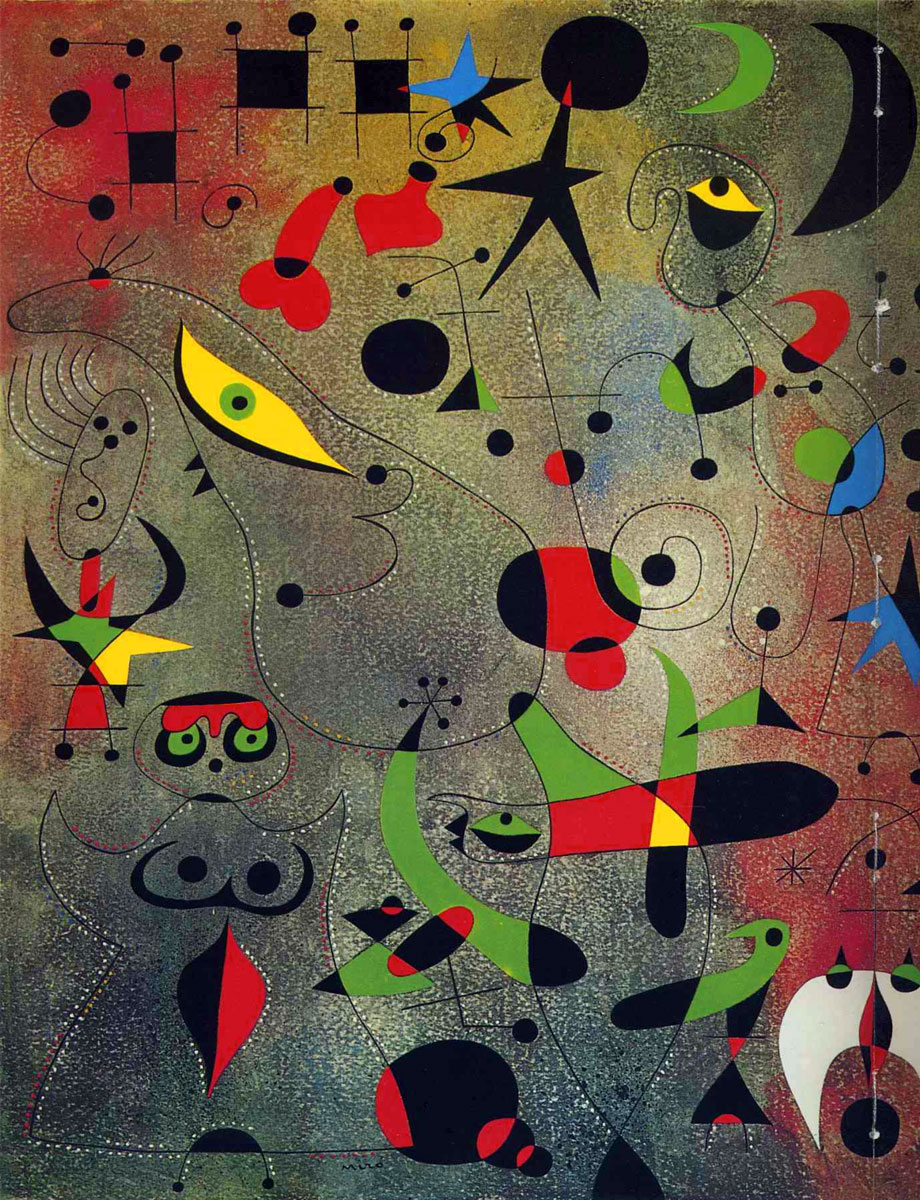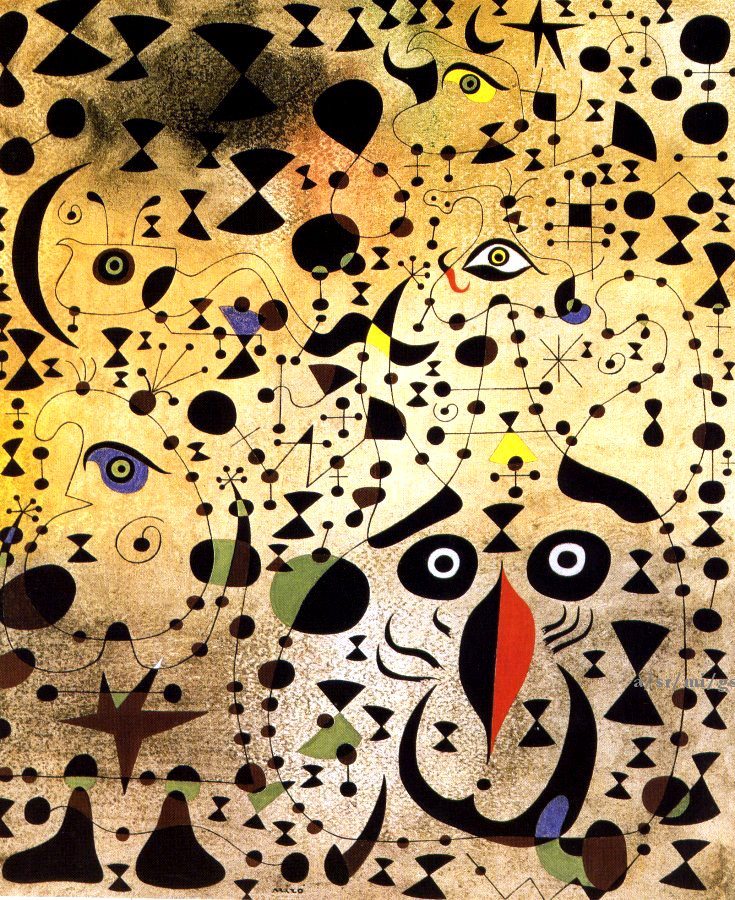
Mirò, La Scala della fuga
Miró’s Constellations are a series of paintings, made between 1940 and 1950, in which the artist mixes painting and visual poetry.
The Constellations are characterised by an explosion of bright colours and fluid lines, creating a sense of movement and mystery. Each work seems to tell an abstract and symbolic story, with shapes that blend and overlap each other.
In this post I show you the most important works in the series and explain what they represent.
The Miró Constellations

The inspiration for Miró’s Constellations comes from the artist’s observation of the night sky. Among the characteristics of Miró’s life and work is a formidable passion for astronomy and the stars, which evoke a sense of connection between the cosmos and his imagination.
The ‘Constellations’ works are composed of organic and abstract elements, such as stylised human figures, birds, stars and symbolic signs. These elements blend together in a poetic expression that invites the viewer to freely interpret the meaning of each painting.
MEANING OF THE CONSTELLATIONS OF MIRÓ
Mirò’s Constellations are an invitation to explore abstract worlds and to be carried away by the evocative power of the imagination. Through the combination of colours, shapes and symbols, Miró allows the viewer to take a real journey into his creative universe, in which painting becomes a means of exploring the boundaries of the human mind and soul.
Miró created a total of 23 paintings over a ten-year period: from 1940 to 1950.
This series represents an important phase of his artistic work and he conceived each ‘Constellations’ painting as an autonomous work. However, the works as a whole form a coherent collection of abstract creations that explore the connection between Miró’s imagination and the cosmos.
STYLE AND TECHNIQUE OF MIRÒ CONSTELLATIONS
The ‘Constellations’ series is characterised by a vibrant colour palette, fluid lines and a combination of stylised figures and abstract symbols. This series of paintings is widely regarded as one of the highlights of Miró’s career and represents his poetic and surreal vision of the world.
In Constellations, Joan Miró uses his distinctive abstract painting style, which combines organic and symbolic elements. His artistic technique for these works ranges from the application of bright, bold colours on canvas to the creation of fluid lines and abstract shapes.
Miró painted spontaneously, letting his imagination guide the creative process. He used a variety of tools, such as brushes, palette knives or even his fingers, to apply paint on the canvas. In some cases, he also used the dripping technique, dripping paint onto the surface to create random effects and a feeling of movement.
This combination of elements creates a dreamlike and mysterious atmosphere, in which the cosmos and the imagination merge into a unique poetic expression.
THE MOST IMPORTANT WORKS IN THE ‘CONSTELLATIONS’ SERIES
Each work in the series is autonomous but together they form a narrative.
Three of the 23 works are worth knowing.

Mirò, La Scala della fuga
- The Fugitive Staircase (1940). Private collection.
Of this period of his life Mirò recalled that ‘I felt a deep desire to escape. I was freely enclosing myself within myself. The night, music and the stars began to play an increasingly important part in my paintings’.
Observing this painting, one seems to perceive the music that the artist listened to while painting and that allows the colours to arrange themselves harmoniously on the canvas.

Mirò, Risveglio all’alba (1941)
- Awakening at Dawn (1941). Private collection.
Music plays a crucial role in the Constellations series, especially that of Bach and Mozart. Each star or individual.are added day by day in a slow but steady progression that allows Miró to know exactly where each element should be placed.
In this painting, colour suggests the morning awakening in the delicate hues that emerge from the rough background. Female figures and birds can be spotted popping out between stars and crescents.

Mirò, L’Uccello meraviglioso rivela l’ignoto a una coppia di amanti (1941)
- The Marvellous Bird reveals the unknown to a pair of lovers (1941). The Museum of Modern Art, MoMA New York.
In this painting, the space is overflowing with signs, the colours are pure, and the line connecting the shapes is extremely thin.
To create this painting, Miró uses the surrealist technique of free flowing images that call each other moon. everything is extremely fluid and seems to follow a musical rhythm.
xxxxxxxxxxxxxxxxxxxxxxxxxxxxxxxxxxxxxxxxxxxxxxxx

Mirò, La Scala della fuga
Le Costellazioni di Mirò sono una serie di dipinti, realizzati tra il 1940 e il 1950, in cui l’artista mescola pittura e poesia visiva.
Le Costellazioni sono caratterizzate da un’esplosione di colori vivaci e linee fluide, che creano un senso di movimento e mistero. Ogni opera sembra raccontare una storia astratta e simbolica, con forme che si mescolano e si sovrappongono l’una all’altra.
In questo post ti mostro le opere più importanti della serie e ti spiego cosa rappresentano.
Le Costellazioni di Mirò

L’ispirazione delle Costellazioni di Mirò deriva dall’osservazione dell’artista del cielo notturno. Tra le caratteristiche della vita e opere di Mirò c’è una formidabile passione per l’astronomia e le stelle, che evocano un senso di connessione tra il cosmo e la sua immaginazione.
Le opere delle “Costellazioni” sono composte da elementi organici e astratti, come figure umane stilizzate, uccelli, stelle e segni simbolici. Questi elementi si fondono insieme in un’espressione poetica che invita lo spettatore a interpretare liberamente il significato di ogni dipinto.
SIGNIFICATO DELLE COSTELLAZIONI DI MIRÒ
Le Costellazioni di Mirò sono un invito a esplorare mondi astratti e a lasciarsi trasportare dalla forza evocativa dell’immaginazione. Attraverso la combinazione di colori, forme e simboli, Mirò permette a chi osserva di compiere un vero e proprio viaggio nel suo universo creativo, in cui la pittura diventa un mezzo per esplorare i confini della mente e dell’anima umana.
Mirò ha realizzato un totale di 23 dipinti in un periodo di tempo di dieci anni: dal 1940 al 1950.
Questa serie rappresenta un’importante fase del suo lavoro artistico e ha concepito ogni dipinto delle “Costellazioni” come un’opera autonoma. Tuttavia, le opere nel loro insieme formano una collezione coerente di creazioni astratte che esplorano il legame tra l’immaginazione di Mirò e il cosmo.
STILE E TECNICA DELLE COSTELLAZIONI DI MIRÒ
La serie delle “Costellazioni” è caratterizzata da una tavolozza di colori vibranti, da linee fluide e da una combinazione di figure stilizzate e simboli astratti. Questa serie di dipinti è ampiamente considerata come uno dei punti salienti della carriera di Mirò e rappresenta la sua visione poetica e surreale del mondo.
Nelle Costellazioni Joan Mirò utilizza il suo distintivo stile pittorico astratto, che combina elementi organici e simbolici. La sua tecnica artistica per queste opere spazia dall’applicazione di colori vivaci e audaci sulla tela alla creazione di linee fluide e forme astratte.
Mirò dipingeva in modo spontaneo, lasciando che la sua immaginazione guidasse il processo creativo. Utilizzava una varietà di strumenti, come pennelli, spatole o anche le dita, per applicare la vernice sulla tela. In alcuni casi, usava anche la tecnica del dripping, facendo gocciolare la vernice sulla superficie per creare effetti casuali e una sensazione di movimento.
Questa combinazione di elementi crea un’atmosfera onirica e misteriosa, in cui il cosmo e l’immaginazione si fondono in un’espressione poetica unica.
LE OPERE PIÙ IMPORTANTI DELLA SERIE “COSTELLAZIONI”
Ogni opera della serie è autonoma ma insieme formano un racconto.
Tra le 23 opere realizzate vale la pena conoscerne tre opere.

Mirò, La Scala della fuga
- La Scala della fuga (1940). Collezione privata.
Di questo periodo della sua vita Mirò ricordò che “Sentivo sentivo un profondo desiderio di evasione. Mi rinchiudevo liberamente in me stesso. La notte, la musica e le stelle cominciarono ad avere una parte sempre più importante nei miei quadri”.
Osservano questo dipinto sembra di percepire la musica che l’artista ascoltava mentre dipingeva e che permette ai colori di disporsi sulla tela armoniosamente.

Mirò, Risveglio all’alba (1941)
- Risveglio all’alba (1941). Collezione privata.
La musica nella serie delle Costellazioni ha un ruolo determinante, soprattutto quella di Bach e Mozart. Ogni stella o singolo.vengono aggiunti giorno dopo giorno in un lento procedere, ma costante, che permette a Mirò di sapere esattamente dove ogni elemento deve essere inserito.
In questo dipinto il colore suggerisce il risveglio del mattino nelle delicate sfumature che emergono dal fondo ruvido. Si possono individuare figure femminili e uccelli che spuntano tra stelle e mezzelune.

Mirò, L’Uccello meraviglioso rivela l’ignoto a una coppia di amanti (1941)
- L’Uccello meraviglioso rivela l’ignoto a una coppia di amanti (1941). The Museum of Modern Art, MoMA New York.
In questo dipinto lo spazio è straripante di segni, i colori sono puri, la linea che collega le forme è sottilissima.
Mirò per realizzare questo dipinto si avvale della tecnica surrealista che prevede il libero fluire delle immagini che si chiamano luna con l’altra.tutto è estremamente fluido e sembra seguire un ritmo musicale.

